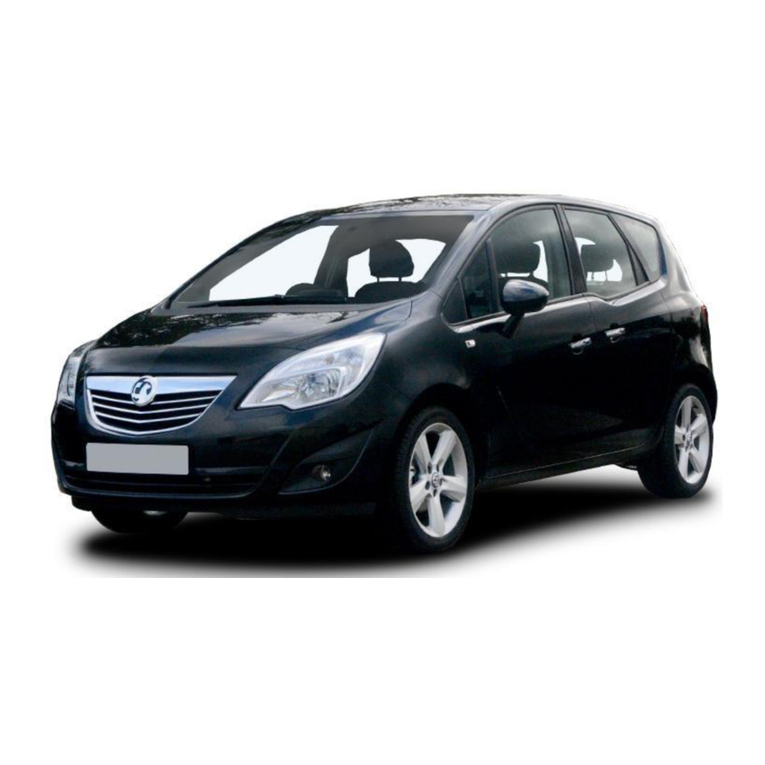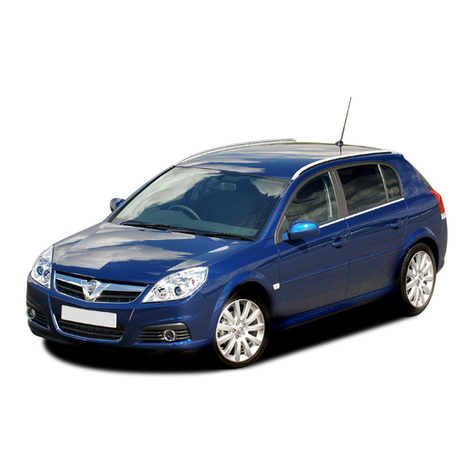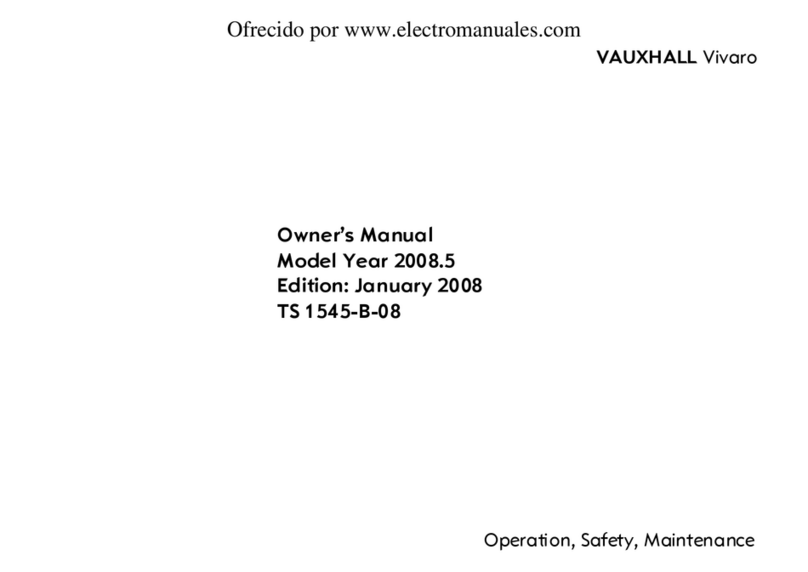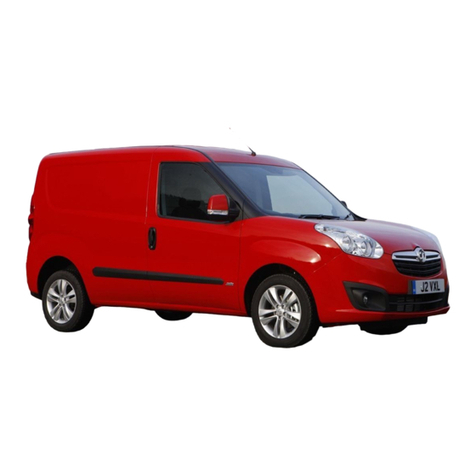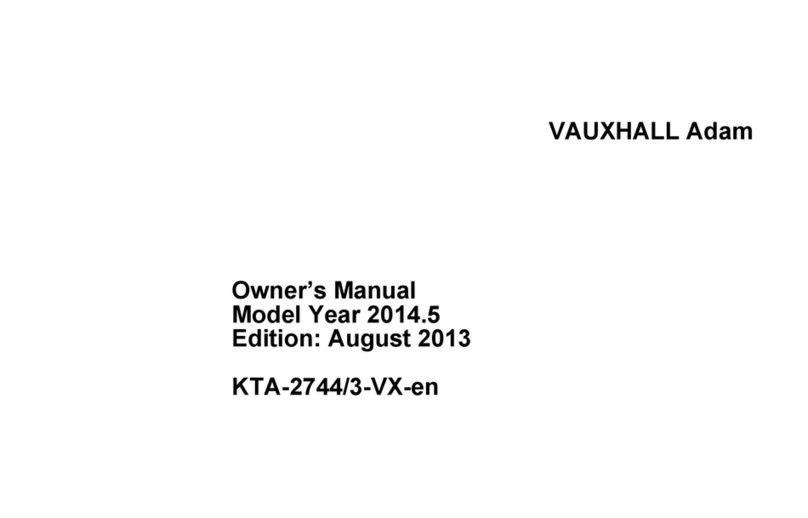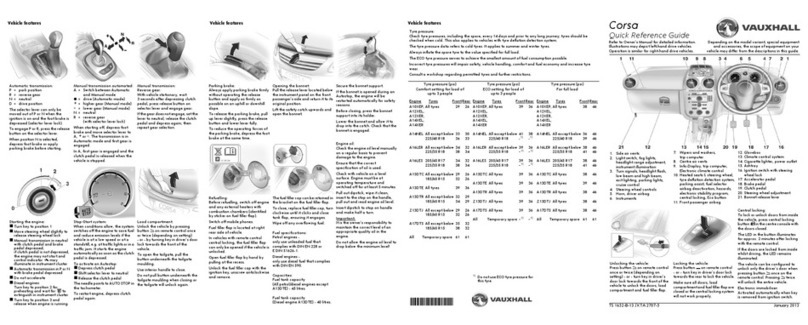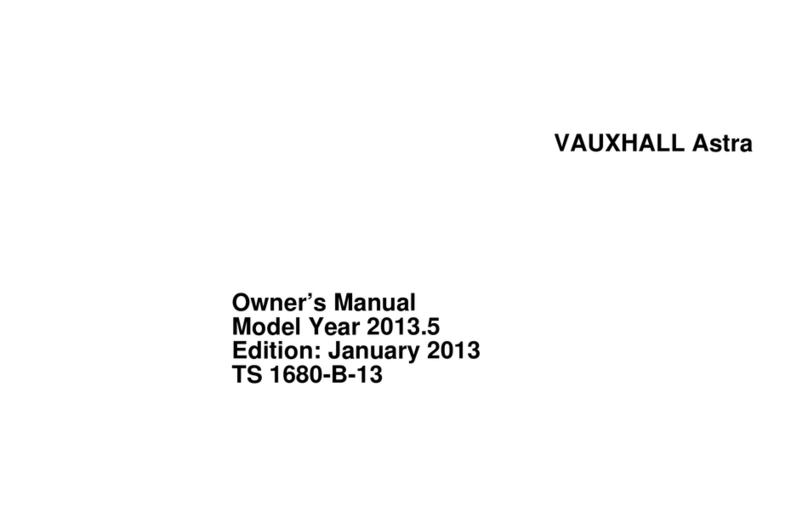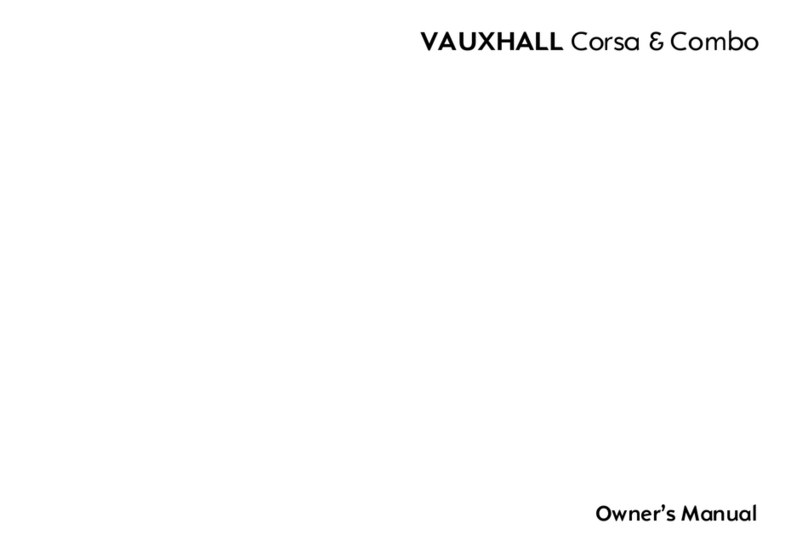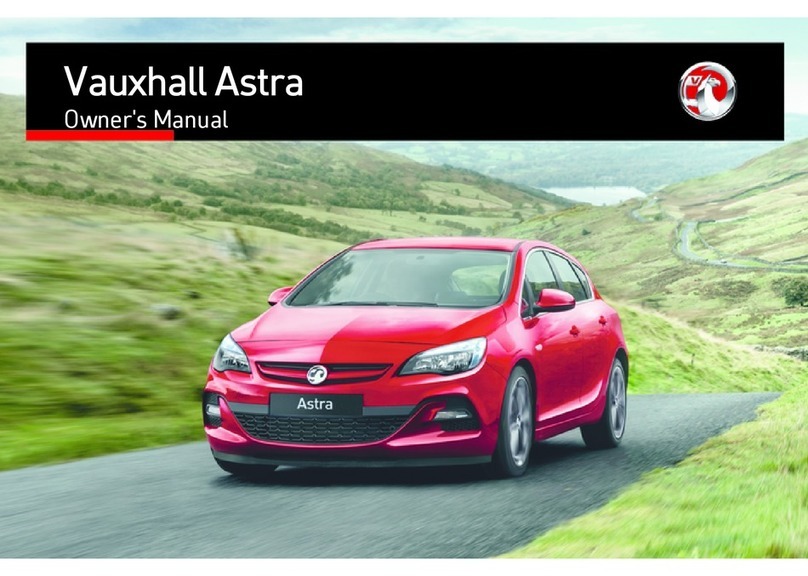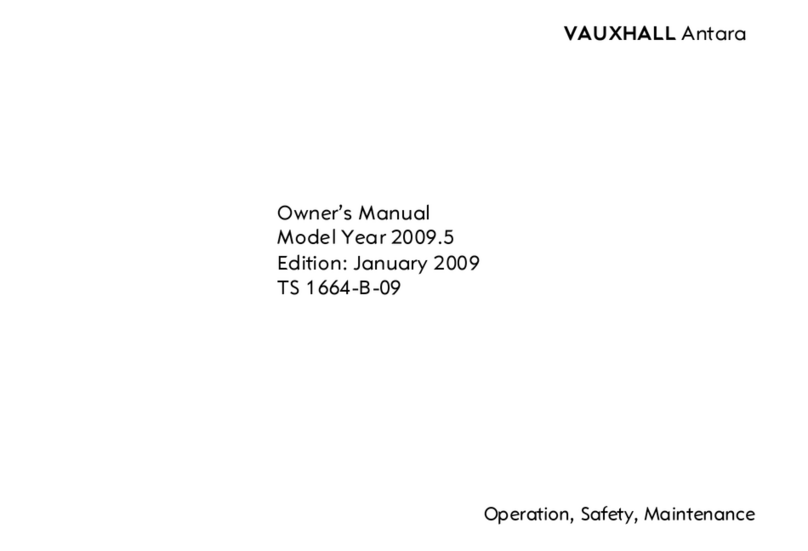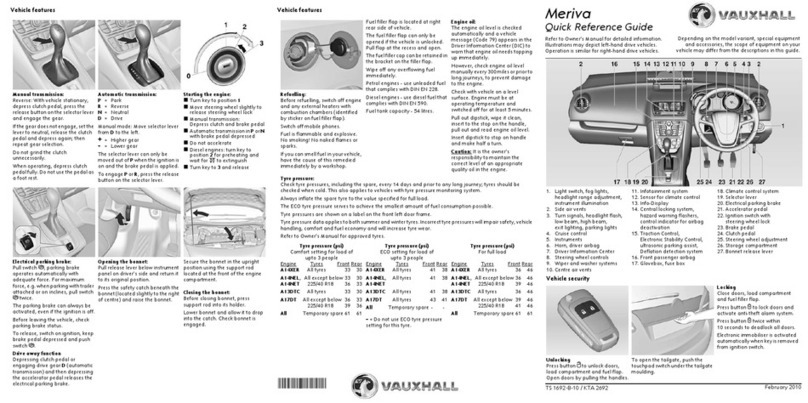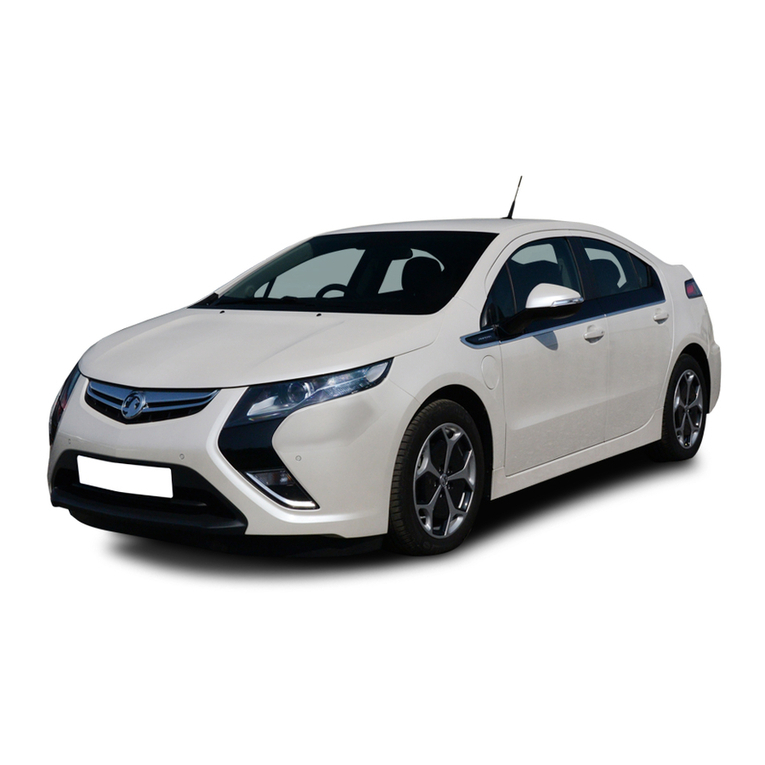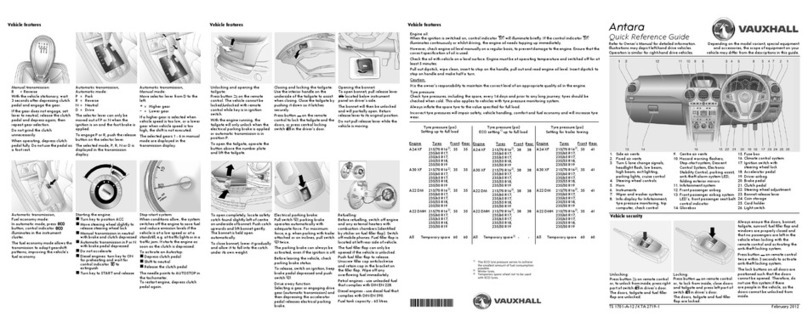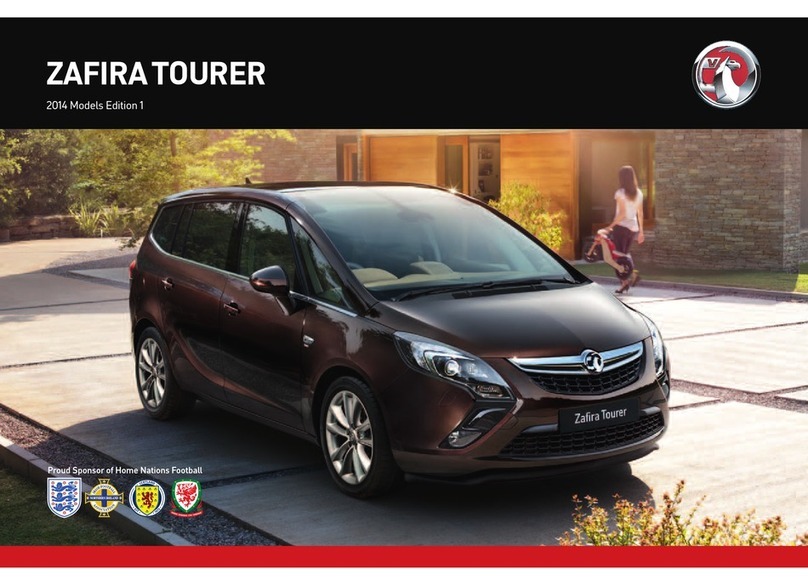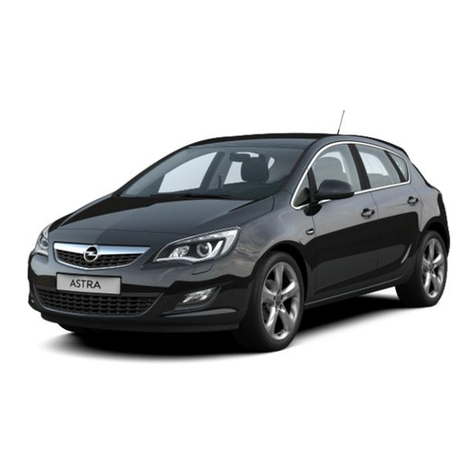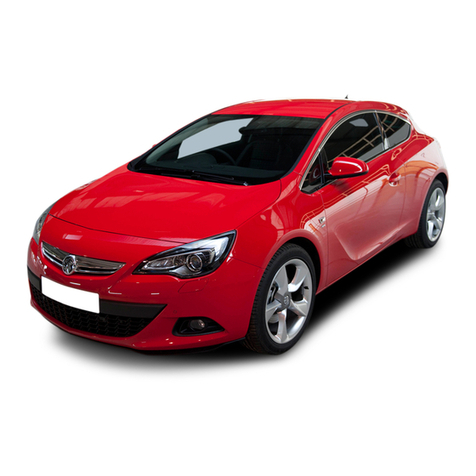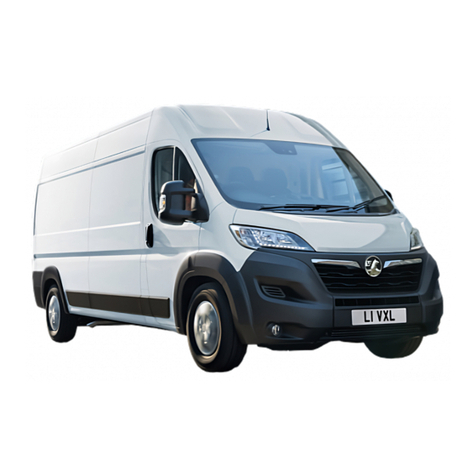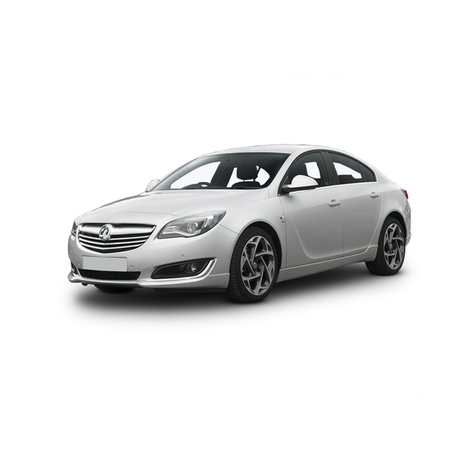Vehicle features Zafira
Quick Reference Guide
Refer to Owner’s Manual for detailed information.
Illustrations may depict left-hand drive vehicles.
Operation is similar for right-hand drive vehicles.
Depending on the model variant, special equipment
and accessories, the scope of equipment on your
vehicle may differ from the descriptions in this guide.
TS 1720-B-13 / KTA 2726-3 January 2013
*KTA-2726-3*
Vehicle features Vehicle features
Unlocking the vehicle:
Press button con remote control
- or - tu r n k ey in drive r ’ s door loc k t o
unlock all doors, load compartment
and fuel filler flap.
Locking the vehicle:
Close doors, load compartment
and fuel filler flap.
Press button eon remote control
- or - turn key in driver’s door lock to
lock the vehicle.
Press etwice within 15 seconds to
deadlock all doors and activate the
anti-theft alarm system.
The vehicle can also be configured
to unlock only the driver’s door,
load compartment and fuel filler
flap when pressing button conce
on the remote control. Pressing
button ctwice will unlock the entire
vehicle.
A short time after unlocking the
vehicle with the remote control, the
doors are locked automatically if
no door has been opened.
Electronic immobiliser:
Activated automatically when key
is removed from ignition switch.
1. Power windows
2. Exterior mirrors
3. Cruise control, speed limiter,
adaptive cruise control,
Forward collision alert
4. Side air vents
5. Wipers and washers
6. Instruments
7. Steering wheel controls
8. Driver Information Centre
9. Turn signals, headlight flash,
low beam, high beam,
exit lighting, parking lights,
buttons for Driver Information
Centre
10. Central locking system,
hazard warning flashers,
Sport and Tour mode,
LEDs for airbag deactivation
and passenger seat belt
11. Info-Display
12. Centre air vents
13. Anti-theft alarm status LED
14. Glovebox, fuse box
15. Climate control system
16. AUX input, USB input,
SD card slot, power outlet
17. Selector lever
18. Traction Control system,
Electronic Stability Control,
lane departure warning
19. Electrical parking brake
20. Parking assist,
advanced parking assist,
stop-start button
21. Ignition switch, steering lock
22. Horn, driver’s airbag
23. Bonnet release lever
24. Storage compartment
25. Steering wheel adjustment
26. Light switch, fog lights,
headlight range adjustment
instrument illumination
Manual transmission:
Reverse gear:
With vehicle stationary, wait
3 seconds after depressing clutch
pedal, press the release button on
the selector lever and engage gear.
If the gear does not engage, set the
lever to neutral, release the clutch
pedal and depress again; then
repeat gear selection.
Do not grind the clutch
unnecessarily.
When operating, depress clutch
pedal fully. Do not use the pedal as
a foot rest.
Automatic transmission:
P= Park position, wheels are
locked, engage only when the
vehicle is stationary and the
parking brake is applied
R= Reverse gear, engage only
when vehicle is stationary
N= Neutral
D= Automatic (drive) mode
with all gears.
The selector lever can only be
moved out of Pwhen the ignition is
on and the brake pedal is applied.
If brake pedal is not applied,
control indicator j illuminates.
To engage Por R, press the release
button.
The engine can only be started with
the lever in position Por N. When
position Nis selected, depress
brake pedal or apply parking brake
before starting.
Manual mode
Move selector lever out of
position Dtowards the left, then
forwards or backwards.
<= Shift to a higher gear
]= Shift to a lower gear
The mode or selected gear is shown
in the transmission display.
Starting the engine:
Turn key to position 1
Move steering wheel slightly to
release steering wheel lock
Manual transmission in neutral
with clutch depressed
Automatic transmission in Por N
with brake pedal depressed
Do not accelerate
Diesel engines: turn key to
position 2for preheating and
wait until control indicator !
extinguishes
Turn key to 3 and release
The key does not have to be held in
position 3- the Automatic Starter
Control ensures that the system will
go on starting automatically until
the engine is running. Because of
the checking procedure, the engine
starts running after a short delay.
Stop-start system:
When conditions allow, the system
switches off the engine to save fuel
and reduce emission levels if the
vehicle is at a low speed or at a
standstill, e.g. at traffic lights or in a
traffic jam. It starts the engine as
soon as the clutch is depressed.
To activate an Autostop:
Depress clutch pedal
Shift selector lever to neutral
Release the clutch pedal
The needle points to AUTO STOP in
the tachometer. To restart engine,
depress clutch again.
Deactivate stop-start system
manually by pressing the eco
button on the instrument panel.
The LED in the button extinguishes
to confirm deactivation.
Manual parking brake:
To release parking brake, raise
lever slightly, press release button
and lower lever fully.
Always apply parking brake firmly
without operating the release
button and apply as firmly as
possible on an uphill or downhill
slope.
To reduce the operating forces of
the parking brake, depress the
brake pedal at the same time.
Opening the bonnet:
To open the bonnet, pull the
release lever located below the
instrument panel.
The bonnet will then be unlocked
and will partially open. Return
release lever to its original position.
To open completely, push the
safety catch to the right and open
the bonnet.
The bonnet is held open
automatically by a lifter.
If the bonnet is opened during an
Autostop, the engine will be
restarted automatically, for safety
reasons.
Closing the bonnet:
To close, lower the bonnet and
allow it to drop into the catch.
Check that the bonnet is engaged.
Electrical parking brake:
Pull switch Jfor approx.
one second; electrical parking
brake is applied automatically with
adequate force. For maximum
force, e.g. when parking with trailer
attached or on inclines, pull
switch Jtwice.
To release, switch on ignition, keep
brake pedal depressed and push
switch J.
Drive away function:
Depressing clutch pedal (manual
transmission) or engaging drive
gear (automatic transmission) and
then depressing the accelerator
pedal releases the electrical
parking brake automatically. This
is not possible when the switch is
pulled at the same time.
This function also helps when
driving away on inclines.
Unlocking and opening tailgate:
Press button c on remote control
when the ignition is off.
The tailgate is released to be
unlocked by pushing the touchpad
switch below the tailgate moulding.
Closing and locking tailgate:
Use interior handle on the
underside of the tailgate to close.
Do not push the touchpad switch
below the tailgate moulding whilst
closing or it will unlock again.
Press button e on remote control to
lock vehicle.
Refuelling:
Before refuelling, switch off engine
and any external heaters with
combustion chambers.
Switch off any mobile phones.
Fuel filler flap is located at right
rear side of vehicle.
The fuel filler flap can only be
opened if the vehicle is unlocked.
Pull flap at the recess and open.
To open, turn the fuel filler cap
slowly anti-clockwise.
The fuel filler cap can be retained in
the bracket on the fuel filler flap.
To close, replace fuel filler cap and
turn clockwise until it clicks.
Wipe off any overflowing fuel.
Petrol engines - use unleaded fuel
meeting specifications of
DIN EN 228 or E DIN 51626-1 or
equivalent.
Diesel engines - use diesel fuel
meeting specifications of
DIN EN 590.
Fuel tank capacity (all models) -
58 litres.
Engine oil:
Check engine oil level manually on
a regular basis to prevent damage
to engine. Ensure that the correct
specification of oil is used.
Check with vehicle on a level
surface. Engine must be at
operating temperature and
switched off for at least 5 minutes.
Pull out dipstick, wipe clean, insert
to stop on the handle, pull out and
read engine oil level.
Insert dipstick to stop on handle
and make half a turn.
Important:
It is the owner’s responsibility to
maintain the correct level of an
appropriate quality oil in the
engine.
A funnel (located in the right
storage compartment in the load
compartment) may be required to
top-up engine oil on some engines.
Tyre pressure:
Check tyre pressures, including the spare, every 14 days and prior to any long journey; tyres should be
checked when cold. This also applies to vehicles with tyre pressure monitoring system.
The tyre pressure data refers to cold tyres. It applies to summer and winter tyres.
Always inflate the spare tyre to the value specified for full load.
The ECO tyre pressure serves to achieve the smallest amount of fuel consumption possible.
Incorrect tyre pressures will impair safety, vehicle handling, comfort and fuel economy and increase tyre
wear.
Warning:
If the pressure is too low, this can result in considerable tyre warm-up and internal damage, leading to tread
separation and even to tyre blow-out at high speeds.
Tyre pressure (psi)
Comfort setting for upto
3 people:
Engine Tyres Front Rear
A14NEL, 215/60 R16 32 32
A14NET 225/50 R17 32 32
235/45 R18 32 32
235/40 R19 32 32
A16XHT 225/50 R17 36 33
225/45 R18 36 33
235/45 R18 36 33
235/40 R19 36 33
A18XEL, 215/60 R16 32 32
A18XER 225/50 R17 32 32
235/45 R18 32 32
235/40 R19 32 32
B16DTH 215/60 R16 35 35
225/50 R17 35 35
235/45 R18 35 35
235/40 R19 35 35
A20DTL, 215/60 R16 35 35
A20DT, 225/50 R17 35 35
A20DTJ 235/45 R18 35 35
235/40 R19 35 35
A20DT1) 215/60 R16 35 35
225/50 R17 35 35
A20DTH,225/50 R17 38 35
A20DTR 225/45 R18 38 35
235/45 R18 38 35
235/40 R19 38 35
All Spare wheel 61 61
1) A20DT ECO.
Tyre pressure (psi)
With full load
Engine Tyres Front Rear
A14NEL, 215/60 R16 33 43
A14NET 225/50 R17 33 43
235/45 R18 33 43
235/40 R19 33 43
A16XHT 225/50 R17 39 46
225/45 R18 39 46
235/45 R18 39 46
235/40 R19 39 46
A18XEL, 215/60 R16 33 41
A18XER 225/50 R17 33 41
235/45 R18 33 41
235/40 R19 33 41
B16DTH 215/60 R16 38 43
225/50 R17 38 43
235/45 R18 38 43
235/40 R19 38 43
A20DTL, 215/60 R16 36 43
A20DT, 225/50 R17 36 43
A20DTJ 235/45 R18 36 43
235/40 R19 36 43
A20DT1) 215/60 R16 38 43
225/50 R17 38 43
A20DTH,225/50 R17 41 46
A20DTR 225/45 R18 41 46
235/45 R18 41 46
235/40 R19 41 46
All Spare wheel 61 61
1) A20DT ECO.
Tyre pressure (psi)
ECO setting for upto
3 people
Engine Tyres Front Rear
A14NEL, 215/60 R16 38 38
A14NET 225/50 R17 38 38
235/45 R18 38 38
235/40 R19 38 38
A16XHT 225/50 R17 41 41
225/45 R18 41 41
235/45 R18 41 41
235/40 R19 41 41
A18XEL, 215/60 R16 38 38
A18XER 225/50 R17 38 38
235/45 R18 38 38
235/40 R19 38 38
B16DTH 215/60 R16 41 41
225/50 R17 41 41
235/45 R18 41 41
235/40 R19 41 41
A20DTL, 215/60 R16 41 41
A20DT, 225/50 R17 41 41
A20DTJ 235/45 R18 41 41
235/40 R19 41 41
A20DT1) 215/60 R16 41 41
225/50 R17 41 41
A20DTH,225/50 R17 41 41
A20DTR 225/45 R18 41 41
235/45 R18 41 41
235/40 R19 41 41
All Spare wheel - 2) - 2)
1) A20DT ECO.
2) Do not use ECO tyre pressure for this
tyre.
